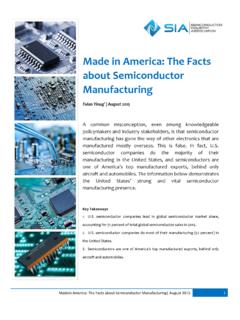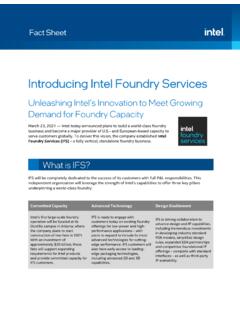Transcription of Global Semiconductor Incentives 2-4-2022
1 Page 1 Global Semiconductor Incentives February 2022 In 2021 alone, 25 fab construction and expansion projects have been announced among foreign partners Europe, South Korea, Japan, Taiwan, and Singapore. In contrast, just 4 have been announced in the United States. Government Incentives are enabling foreign competitors to outpace the in fab construction and investment. semiconductors are a strategic technology essential to American national security, competitiveness, and innovation. As the brains of modern technology, they play a powerful role in the future of our nation s advanced defense systems, critical infrastructure and supply chains, and economic prosperity. The United States has been the long-standing Global leader in this critical technology, with 45-50% share of worldwide revenue in the last 30 years. However, during this same period, share of Global Semiconductor manufacturing capacity has steadily eroded from 37% in 1990 to just 12% in 2020.
2 This is a consequence of the cost of building and operating fabs in the United States relative to that of alternative locations. The ten-year total cost of ownership of a new fab located in the is 30-50% higher than in competing countries - and 40-70% of this cost is attributable to foreign government Incentives . In response, the Senate enacted in June 2021, the Creating Helpful Incentives for the Production of semiconductors (CHIPS) for America Act, which would infuse $52 billion into Semiconductor research, design, and manufacturing in the United States. Funding for this legislation, however, has since stalled in the House of Representatives and currently as part of a broader competitiveness package, Innovation and Competition Act (USICA) ( ), which the House and Senate are continuing to negotiate. In the interim, foreign governments with large footprints in the Global Semiconductor industry are rolling out major federal incentive programs.
3 Global Incentives Landscape CHINA In August 2020 and early 2021, the State Council of China upgraded policy guidance1 for semiconductors that extends and expands preferential tax, finance, and policy measures to further promote the development of its integrated circuit (IC) industry. The renewed Incentives include: a 10-year corporate income exemption for advanced technology process nodes (28nm and below), 5-year exemption for 65nm and below nodes fabrication lines, 2-year exemption for 130nm and below fabrication lines, and import duty exemptions for IC manufacturers to purchase imported Semiconductor materials and equipment. Page 2 INDIA India in December approved a deal to spend $30 billion to position India as Global hub for electronics manufacturing with semiconductors as the foundational building block. 2 $10 billion is earmarked for a special Semiconductor and display manufacturing ecosystem development program and another $ billion for incentive programs, such as the Scheme for Promotion of manufacturing of Electronic Components and semiconductors (SPECS) and production-linked incentive (PLI) plans for Large Scale manufacturing , and IT Hardware.
4 This includes the establishment of High Tech Clusters with requisite infrastructure to approve applications for at least two greenfield Semiconductor fabs and two display Under this plan, the government will provide up to 50% co-funding for fabs and cover up to 50% of eligible expenditure for 100 Semiconductor design SOUTH KOREA South Korea in May unveiled the K- Semiconductor Belt strategy aimed at building the world s largest Semiconductor supply chain by 2030. The initiative offers investment tax credits on Semiconductor R&D up to 50% and on facility investments up to 20% to attract more than $450 billion private sector investment in the domestic Semiconductor industry by Under this plan, South Korea s two leading Semiconductor firms pledged to collectively spend $355 billion through JAPAN Japan in November approved $ billion in funding for domestic Semiconductor investment as a part of its goal to double domestic chip revenue to $114 billion by $410 million will be spent on legacy production and $960 million on R&D of next-generation $ billion will provide funding for innovative chip manufacturing production capacity, a part of which will cover up to 50% of the construction cost of a TSMC plant in Kumamoto prefecture.
5 TSMC has committed to an initial investment of up to $ billion with an additional $500 million supplemented by Sony to create its Japan-based EUROPEAN UNION The European Union in June unveiled that it would allocate up to 20% of its new $917 billion Covid recovery fund toward digital infrastructure, a sizable portion of which would focus on the microelectronics European Commission President in September proposed a $30-$50 billion European Chips Act to double the EU s current 10% share of the Global Semiconductor market by 2030 through a dedicated European Semiconductor Fund and create a state-of-the-art European chip France in November announced plans to invest $ billion into joint European investment projects for Germany in December selected 32 Semiconductor materials, design, and manufacturing projects to be funded under a $12 billion investment fund in microelectronics projects announced earlier in Urgency of Funding the CHIPS for America Act As foreign governments are passing major incentive programs in response to the CHIPS for America Act, Global demand for semiconductors is forecast to increase at a cumulative average rate of 5% over the next decade.
6 Corresponding with this growth, Global Semiconductor manufacturing capacity is expected to grow by 56% from its current base by 2030. As of June 2020, half of this new capacity is a white space of opportunity for the United States to attract the future fabs that will fill this demand. With existing Incentives , however, the is expected to attract only 6% of future capacity, which would translate to further decline in share from 12% in 2020 to 10% in 2030. A substantial federal incentive program is needed to reverse the decline of manufacturing leadership and reestablish the United States as a competitive location for Semiconductor manufacturing . According to analysis by the Boston Consulting Group, a $50 billion incentive program could make Incentives competitive enough to attract 19 new fabs, or 24% share of the addressable new capacity entering the market in the next decade. This would increase share of Global installed capacity from 12% in 2020 to 13-14% in 2030 and capacity located in the United States by 57%, effectively reversing the prevailing trend over the past 30 years.
7 The next ten years is a critical period for solving the gap in cost competitiveness and leveraging the comparative strength of our skilled talent pool, intellectual property laws, and existing ecosystem to secure the United States position in the expanding Global Semiconductor market. The window of opportunity, however, is rapidly closing. Funding for Semiconductor research, design, and manufacturing incentive programs is crucial to maintaining our technological edge in an increasingly crowded field of capable and motivated competitors and this is a fight that we cannot afford to lose. Page 3 [1] [2] [3] Ibid [4] [5] [6] Ibid [7] [8] [9] [[10]] [11] [12] [13]
















